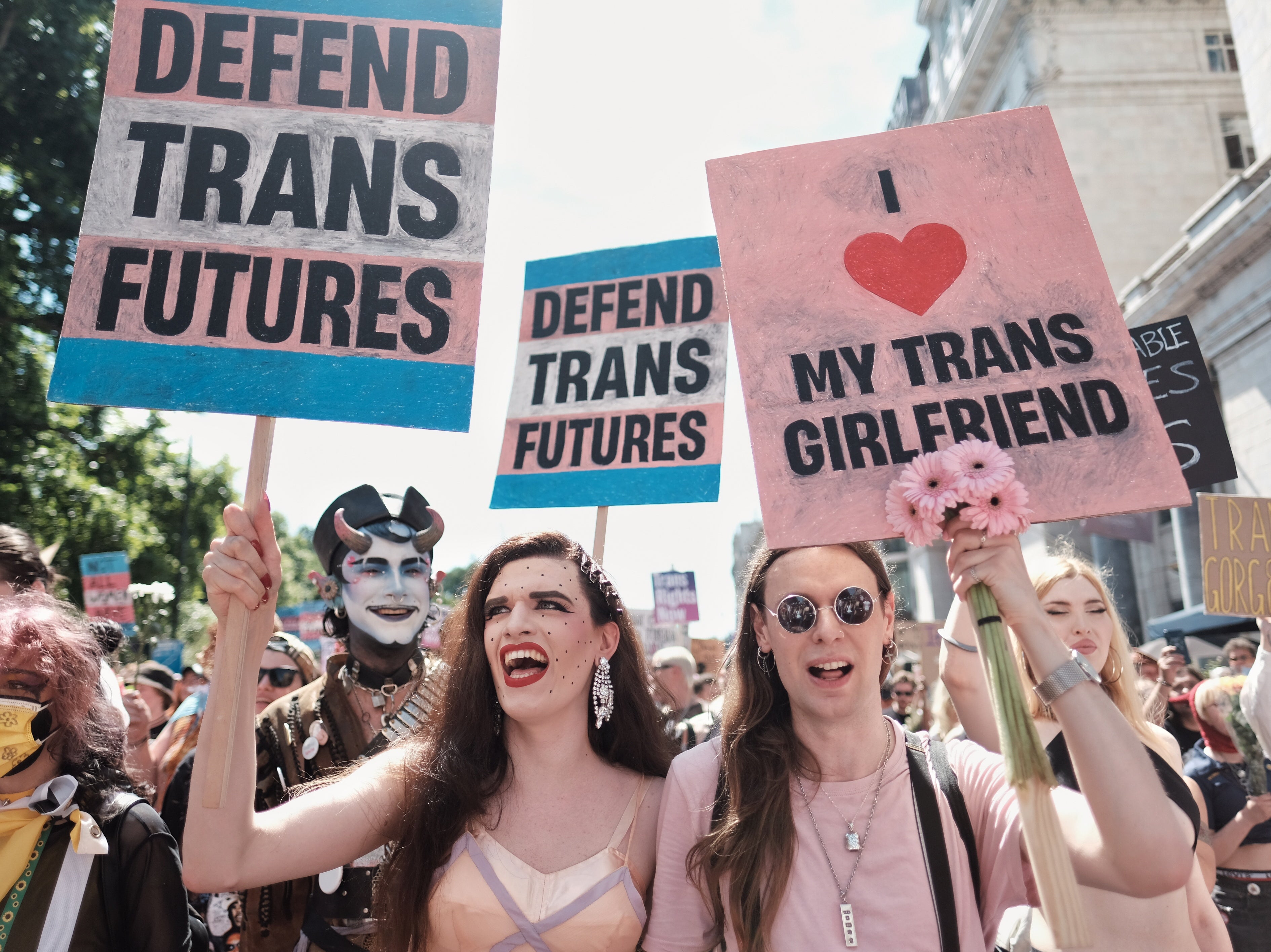Understanding Trans Eros: Love, Identity, And Connection
In a world increasingly seeking to understand and embrace the vast spectrum of human experience, the concept of "trans eros" emerges as a vital area of exploration. This term, while perhaps unfamiliar to some, delves into the intricate tapestry of love, desire, intimacy, and self-acceptance as experienced by transgender individuals. It's about more than just romantic relationships; it encompasses the profound journey of self-discovery, the yearning for authentic connection, and the societal landscape that shapes these experiences.
Understanding "trans eros" requires a foundation in what it means to be transgender. As an umbrella term, "transgender" describes individuals whose gender identity—their internal sense of being male, female, both, neither, or somewhere else on the gender spectrum—or gender expression differs from the sex they were assigned at birth. This fundamental aspect of identity profoundly influences how one experiences love, forms relationships, and navigates the world of desire. This article aims to illuminate the nuances of trans eros, providing insights into its challenges, triumphs, and the vital importance of fostering affirming and understanding environments.
Table of Contents
- Defining "Transgender" and "Trans Eros"
- The Journey of Self-Discovery and Identity
- The Trans Flag: A Symbol of Identity and Love
- Navigating Relationships and Intimacy
- Societal Perceptions and Challenges
- Mental Health and Well-being in Trans Eros
- Building Inclusive Spaces for Trans Eros
- The Future of Trans Eros: Acceptance and Flourishing
Defining "Transgender" and "Trans Eros"
To truly grasp "trans eros," we must first clarify the foundational term: "transgender." While "trans" is often used as shorthand for "transgender," it's crucial to understand that transgender is an umbrella term used to describe people whose gender identity (their internal sense of themselves as male or female, or another gender) or gender expression differs from socially defined norms associated with the sex they were assigned at birth. It's important to note that while "transgender" is generally a good term to use, not everyone whose appearance or behavior is gender non-conforming identifies as transgender, highlighting the diverse ways individuals experience and express their gender.
With this understanding, "trans eros" can be broadly defined as the experience of love, desire, and intimacy through the lens of a transgender identity. This isn't just about sexual attraction; it encompasses a much wider spectrum of human connection. It includes self-love and self-acceptance, the desire for authentic relationships (both romantic and platonic), the yearning for affirmation, and the navigation of societal perceptions regarding trans bodies and identities in the context of desire. It’s about the full emotional and relational landscape, acknowledging the unique joys, challenges, and triumphs inherent in this journey. The concept challenges conventional notions of desire, pushing us to recognize and celebrate love in all its diverse forms, especially when it transcends traditional gendered expectations.
The Journey of Self-Discovery and Identity
The path to understanding one's gender identity is deeply personal and varies greatly among individuals. Some people realize their trans identities or begin to experiment and explore gender non-conforming attitudes and behaviors during adolescence, while others may discover this much later in life. This journey of self-discovery is a critical component of "trans eros," as authentic love and intimacy often stem from a deep understanding and acceptance of oneself. For many transgender individuals, this process involves navigating complex emotions, societal expectations, and sometimes, internal conflict before arriving at a place of self-affirmation.
This internal journey is inextricably linked to how one experiences and expresses desire. When a person aligns with their true gender identity, they often feel a greater sense of wholeness and authenticity, which can profoundly impact their capacity for intimacy and connection. The "eros" here isn't just about attracting others; it's about cultivating a loving relationship with oneself, a prerequisite for healthy external relationships. The challenges faced during this discovery, such as dysphoria or societal misunderstanding, can shape how trans individuals approach love and vulnerability, making affirming environments and partners even more crucial.
- Amateur Cameltoe
- Scarlett Johansson Sexy Gif
- News Record In Gillette Wy
- Kenny Anderson
- Bottomesa Meaning
The Trans Flag: A Symbol of Identity and Love
Symbols play a powerful role in fostering identity, community, and a sense of belonging. The trans flag, introduced in 1999 by Monica Helms, is one such potent symbol. It has five horizontal stripes of equal size: two light blue, two light pink, and one white stripe in the middle. The light blue stripes represent the traditional color for baby boys, while the light pink stripes represent the traditional color for baby girls. The white stripe is for those who are intersex, transitioning, or consider themselves having a neutral or undefined gender. This flag is not just a piece of fabric; it embodies the collective "trans eros"—the shared love, pride, and solidarity within the transgender community.
The flag serves as a visual representation of trans identity and a beacon of hope and acceptance. For many, seeing the trans flag displayed can evoke a sense of safety and recognition, signifying that they are seen, valued, and understood. This visual affirmation contributes to a positive sense of self, which is fundamental to healthy expressions of "trans eros." It signals to the world that trans people exist, are diverse, and deserve love and respect, fostering an environment where authentic relationships can flourish.
Navigating Relationships and Intimacy
Navigating relationships and intimacy as a transgender individual comes with its own unique set of considerations, shaping the landscape of "trans eros." While the fundamental human desires for connection, love, and partnership remain universal, transgender people often encounter specific challenges and triumphs in their romantic and sexual lives. These can range from disclosing one's trans identity to potential partners, managing societal misconceptions, to finding partners who are truly affirming and understanding of their gender identity and journey. The experience of "trans eros" is deeply personal, reflecting the diversity of trans identities and attractions.
For some, transitioning brings a renewed sense of confidence and authenticity, which can open up new avenues for intimacy. For others, past negative experiences or societal pressures might create barriers. The key lies in seeking out relationships built on mutual respect, open communication, and genuine acceptance. This often means challenging preconceived notions of gender and sexuality, both within oneself and in potential partners. Ultimately, the goal is to cultivate relationships where a transgender person feels seen, desired, and loved for who they authentically are, fostering a healthy and fulfilling "trans eros."
Communication and Consent in Trans Eros
Effective communication and explicit consent are paramount in any healthy relationship, but they take on particular significance in the context of "trans eros." For transgender individuals, discussions around identity, pronouns, preferred names, and physical comfort are essential for ensuring a respectful and affirming intimate experience. Partners must be willing to listen, learn, and adapt their understanding of gender and sexuality beyond binary norms. This includes open conversations about bodies, desires, and boundaries, ensuring that all interactions are consensual, respectful, and affirming of the transgender person's identity.
Consent in "trans eros" extends beyond just sexual acts; it encompasses respecting a person's identity at all times. Misgendering, deadnaming, or making assumptions about a trans person's body or sexual history are all forms of disrespect that violate trust and undermine intimacy. A truly affirming partner understands that respect for identity is foundational to any form of "eros."
Finding Affirming Partners
One of the most significant aspects of "trans eros" is the quest for affirming partners. An affirming partner is someone who not only accepts a transgender person's identity but actively celebrates and supports it. This goes beyond mere tolerance; it involves a deep understanding and respect for their journey, their gender expression, and their chosen pronouns. Finding such partners can sometimes be challenging due to societal prejudices and a lack of education about transgender identities.
However, many resources and communities exist to help transgender individuals connect with affirming partners. Online dating platforms specifically designed for LGBTQ+ individuals, local community groups, and social networks can be invaluable. The key is to prioritize partners who demonstrate genuine empathy, a willingness to learn, and an unwavering commitment to respecting and cherishing one's authentic self. When a transgender person finds an affirming partner, it can lead to incredibly deep, joyful, and healing expressions of "trans eros," allowing them to experience love and desire without the burden of concealment or misunderstanding.
Societal Perceptions and Challenges
The broader societal context significantly impacts the experience of "trans eros." Despite growing visibility and acceptance, transgender individuals still face considerable prejudice, discrimination, and misunderstanding. These challenges can manifest in various ways, from overt hostility to subtle microaggressions, all of which can impede the ability to form healthy and fulfilling relationships. The media's portrayal of transgender people, often sensationalized or misinformed, can perpetuate harmful stereotypes that affect how trans individuals are perceived in romantic and intimate contexts.
Issues like trans sports bans, as highlighted by resources supporting transgender youth and their families, demonstrate the ongoing struggle for basic recognition and rights. Such policies and public debates, while seemingly unrelated to "eros," contribute to a climate of hostility that can impact a transgender person's self-esteem and sense of safety in expressing their authentic self, including their desires and capacity for love. The fear of rejection, violence, or fetishization can lead to isolation and a reluctance to seek intimacy. Overcoming these societal barriers requires ongoing education, advocacy, and a collective commitment to fostering a more inclusive and understanding world where "trans eros" can flourish without fear.
Mental Health and Well-being in Trans Eros
The mental health and well-being of transgender and nonbinary people are critical considerations, especially when discussing "trans eros." Unfortunately, these communities disproportionately suffer from suicidality and other mental health issues. According to a survey by The Trevor Project of over 40,000 LGBTQ+ youth, a significant percentage of transgender and nonbinary youth reported seriously considering suicide. This stark reality underscores the profound impact of societal discrimination, lack of acceptance, and the challenges associated with gender dysphoria.
The ability to experience healthy "trans eros"—to love oneself, to be loved authentically, and to pursue intimate connections—is deeply intertwined with mental well-being. When individuals face constant invalidation, discrimination, or a lack of affirming spaces, it can severely impact their self-worth and their capacity for healthy relationships. Conversely, supportive environments, affirming relationships, and access to mental health resources can significantly mitigate these risks, fostering resilience and promoting a positive sense of self, which is essential for any form of "eros." Addressing these mental health disparities is not just about crisis intervention; it's about creating a world where "trans eros" can thrive in safety and joy.
The Role of Community Support
In the face of mental health challenges and societal pressures, community support plays an invaluable role in fostering healthy "trans eros." For transgender individuals, connecting with others who share similar experiences can provide a sense of belonging, validation, and mutual understanding that is often lacking in broader society. These communities offer safe spaces where individuals can express their authentic selves without fear of judgment, share their journeys, and find solidarity.
Community support can manifest in various forms: online forums, local LGBTQ+ centers, support groups, and chosen families. These networks provide emotional support, practical advice, and a sense of collective strength. They help combat feelings of isolation and loneliness, which are significant contributors to mental health issues. Within these communities, "trans eros" is not just about individual relationships but also about the collective love, care, and affirmation that members extend to one another, reinforcing self-worth and enabling individuals to pursue healthy intimacy with greater confidence and resilience.
Building Inclusive Spaces for Trans Eros
To truly support and celebrate "trans eros," it is imperative to actively build and promote inclusive spaces. These spaces are environments where transgender individuals feel safe, respected, and affirmed in their identities, allowing them to express love and desire authentically without fear of discrimination or harm. This goes beyond mere tolerance; it requires active allyship, education, and the dismantling of cisnormative and heteronormative biases.
Inclusive spaces can be found in various settings: homes, workplaces, schools, healthcare facilities, and social venues. Key elements include using correct pronouns, respecting chosen names, providing gender-neutral facilities, and educating staff and peers about transgender identities and experiences. For "trans eros" specifically, this means creating dating apps and platforms that are genuinely inclusive, ensuring sex education is trans-inclusive, and challenging the fetishization or dehumanization of trans bodies. When society commits to building these inclusive spaces, it fosters an environment where "trans eros" can flourish, allowing individuals to experience love, intimacy, and desire in ways that are affirming, respectful, and joyful.
The Future of Trans Eros: Acceptance and Flourishing
The journey towards full acceptance and flourishing for "trans eros" is ongoing, but the trajectory is towards greater understanding and inclusion. As conversations about gender identity become more widespread and nuanced, there is a growing recognition of the diverse ways in which people experience love and desire. The future of "trans eros" hinges on continued education, advocacy, and the dismantling of systemic barriers that prevent transgender individuals from living full, authentic, and loving lives.
This future envisions a world where transgender people can pursue relationships, express their desires, and experience intimacy without fear of judgment, discrimination, or violence. It's a future where self-love is nurtured, and external relationships are built on genuine respect and affirmation. By continuing to support transgender youth and their families, championing inclusive policies, and challenging harmful stereotypes, we contribute to a society where "trans eros" is not just tolerated but celebrated as a beautiful and integral part of the human experience. The strength and resilience of the trans community, coupled with the growing number of allies, promise a future where love, in all its forms, knows no bounds.
Conclusion
The concept of "trans eros" invites us to expand our understanding of love, desire, and intimacy beyond conventional boundaries. It highlights the unique journeys of transgender individuals in discovering their authentic selves and seeking profound connections. From the symbolic power of the trans flag to the critical importance of mental well-being and community support, "trans eros" is a rich and multifaceted aspect of human experience that deserves recognition and respect.
As we move forward, it is vital that we continue to build inclusive spaces, foster open dialogue, and champion the rights and dignity of transgender people. By doing so, we not only support healthy "trans eros" but also enrich the fabric of our society as a whole. We encourage you to reflect on these insights, challenge your own perceptions, and become an ally in creating a world where every individual can experience love and intimacy authentically. Share this article to spread awareness, and consider exploring more resources from organizations like The Trevor Project to deepen your understanding and support for the transgender community.

‘It’s about sharing knowledge, pain, joy’: meet the people marching in

Was ist Trans? - i2TransHealth

See Gorgeous Portraits from the First Trans Prom in Front of the U.S